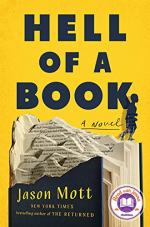|
This section contains 721 words (approx. 2 pages at 400 words per page) |

|
Hell of a Book Summary & Study Guide Description
Hell of a Book Summary & Study Guide includes comprehensive information and analysis to help you understand the book. This study guide contains the following sections:
This detailed literature summary also contains Quotes and a Free Quiz on Hell of a Book by Jason Mott.
The following version of this book was used to create the guide: Mott, James. Hell of a Book. Penguin Random House LLC., 2021.
James Mott's novel Hell of a Book is written from both the first and third person points of view, and employs both the past and present tenses. The narrative alternates between the two main characters Soot's and an unnamed first person narrator's accounts. Although each section shifts between these formal stances, the following summary employs the present tense and a linear mode of explanation.
When Soot is a little boy living in North Carolina with his parents, he learns the importance of disappearance. His father, William, especially wants his son to know how to make himself invisible, because he fears what dangers might befall Soot as a Black boy living in the South.
William desperately wants to convey the significance of his racial identity to his son, but fears robbing his son of his innocence, optimism, and hope. He is also wary of doing to Soot what his father did to him. His father, Daddy Henry, made William hate his Blackness and thus himself. William has no interest in inflicting this experience on his young child.
One night while William is out for an evening run, a cop pulls over next to him. He demands to see William's identification. William says that his license is at home. He tells the cop his house is the one right in front of them and he can run inside to get it. William's wife and son see the police lights outside and open the front door. Suddenly the cop shoots William and kills him.
Over the following months and years, Soot learns to rely on his imagination to survive his shock and grief. He starts imagining that his dead father is spending time with him. He also imagines himself into other worlds where he is safe to be whoever he wants to be. His mother starts worrying about him and takes him to see a psychiatrist, who puts Soot on medication. Soot stops taking the pills shortly thereafter, because they preclude his ability to think, feel, or imagine.
Years later, an unnamed first person narrator is on a book tour for his recently published novel, Hell of a Book. No matter where he travels, the narrator is distracted and detached. He gives the same interviews and the same readings. Though he is proud of his book, he also hates talking about it. He can barely even remember what it is about.
Over the course of the tour, the narrator perpetually hears people talking about a young Black boy who was recently killed by a police officer. Whenever anyone mentions this event, the narrator feigns sympathy and upset. In reality, he has no idea about the true story, and no interest in becoming involved in it.
When he arrives in San Francisco, his driver, Renny, takes him to a bookstore for an evening reading. On their way, they encounter hordes of people protesting the recent shooting. Renny demands to know what the narrator thinks of this tragedy and the march. He says that because the narrator is a writer and a Black man, it is his responsibility to have an opinion. The narrator resists this idea. He has no interest in activism.
After the reading, the narrator meets a beautiful woman named Kelly. They have dinner together and go out for drinks. Kelly's lack of interest in the narrator's book surprises and delights him. Finally he can be himself. Then, when Kelly asks the narrator to accompany her to the funeral home where she works for a last minute job, the narrator grows uncomfortable. He feels even more upset when he realizes that the body of the boy from the news is lying on a gurney nearby.
The narrator's agent arranges two impromptu stops at the end of the narrator's tour. She first wants him to go to his hometown in Bolton, North Carolina. Then she wants him to go to Denver, Colorado to speak to the dead boy's mother. These trips challenge the narrator's mental and emotional states. However, by the end of these ventures, the narrator is finally able to confront the truth of his childhood trauma, which starkly resembles Soot's, and to pursue change and renewal.
Read more from the Study Guide
|
This section contains 721 words (approx. 2 pages at 400 words per page) |

|



